Basque Cooking Meets Japanese Tableware: A Harmonious Blend
Jan 08,2016
Basque Cooking Meets Japanese Tableware: A Harmonious Blend
Jan 08,2016
Wherever you go in Japan, you’ll find pieces of tableware with a character all their own. They reflect the country’s cultural diversity and the vision of the artists who made them. Their presence enriches our daily lives.
Here we feature tableware by artist Ito Kan paired with cuisine prepared by chef Muto Yasuyuki. This collaboration was arranged with the assistance of Eto Aya, proprietor of the gallery Natsutsubaki.
On this particular day, the gallery Natsutsubaki had visitor: Chef Muto Yasuyuki, who studied culinary arts in Paris, Burgundy, and the Basque region, then honed his skills at a historic French restaurant in Tokyo. We had a special request for him. We wanted him to take a single bowl and showcase it in different ways by serving different foods in it.
The tableware that Yasuyuki selected in advance was by artist Ito Kan, a name generally associated with Western-style ceramics combining tenderness with a stately delicacy. For this occasion, however, he had made a wide variety of works on a Japanese theme to show at a special exhibition. Yasuyuki selected one of these, known playfully as the “contact lens bowl,” as the centerpiece of the day’s meal. This beautiful deep green bowl has the same sleek, curved profile as a contact lens. With its enamel-like sheen and deep, complex green color, it might leave you wondering at first. What type of cuisine can you serve in it? How can you use to present food attractively? Yasuyuki set to work in the kitchen as our anticipation mounted. In what ways would he showcase the bowl?
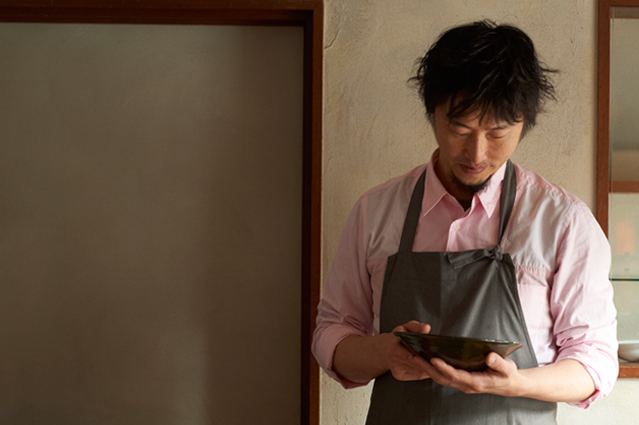

The first item he made was shrimp salad with Tasmanian mustard dressing. He carefully arranged radishes, karashina mustard greens, and shrimp in the bowl, then garnished them with chips made from deep-fried spring roll wrappers. The sight of purple, orange, and other colors being added layer by layer to the green bowl was breathtakingly beautiful to behold. By the time the salad was ready, the bowl had assumed a completely different character from when it stood empty.
“The first thing that came to mind was a salad,” Yasuyuki explains. “I figured that some brightly colored vegetables would look eye-catching in this bowl. A dish like this that’s not too deep and has a raised rim looks beautiful with some vegetables nonchalantly tossed in on top of each other. Starting the salad small and piling it high creates a particularly attractive effect.”


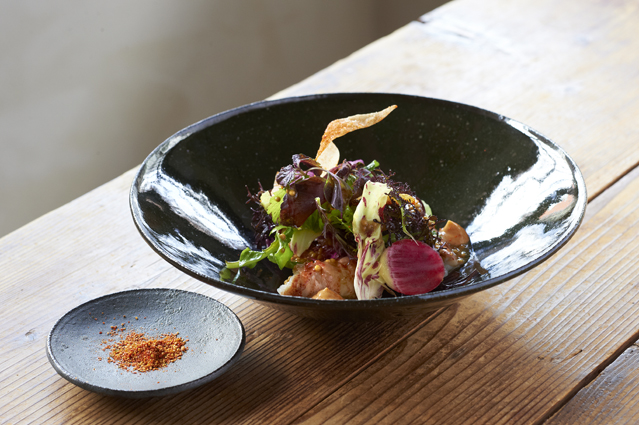 A salad consisting of vegetables cut out in perfect circles like contact lenses, a nod to the concept behind the bowl. This is the kind of nice playful touch typical of Muto Yasuyuki.
A salad consisting of vegetables cut out in perfect circles like contact lenses, a nod to the concept behind the bowl. This is the kind of nice playful touch typical of Muto Yasuyuki.
The second item on the menu was piperade, a traditional family dish of the Basque region. Piperade consists of green peppers stewed in tomato sauce à la ratatouille and combined with beaten eggs. On this occasion, it was served on a slice of bread with dry-cured ham.
“The way this dish gleams reminded me of French earthenware with a shiny glaze. I also figured the dish would go well with the color of bread. So I combined a slice of bread with piperade, which the Basques eat daily.”
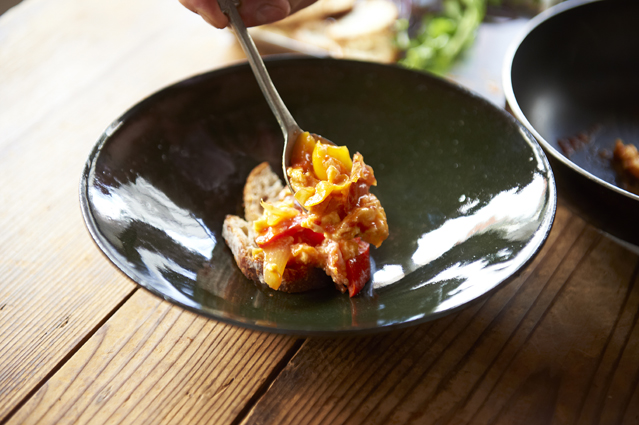
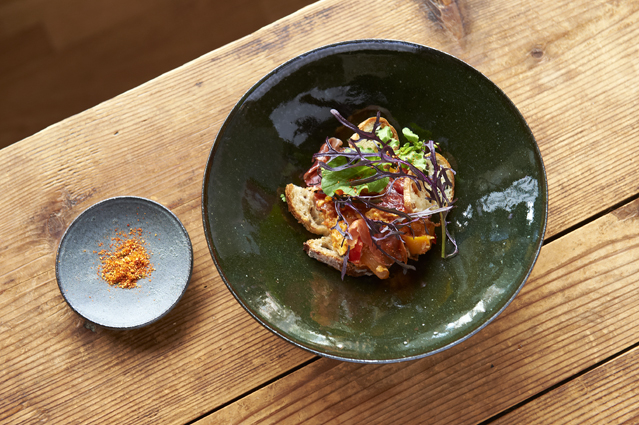
“Green and red are a color combination beloved of the Basque people, being the colors of the Basque flag,” Yasuyuki explains. “In that sense, I think this dish succeeds in capturing the essence of Basqueness, the hallmark of my culinary journey.”
The third dish was an apple dessert, tarte Tatin.
“When I first saw this bowl, I has this urge to combine it with white. Then I thought of using it to serve tarte Tatin with a sauce made from fromage blanc, a type of French cheese. I’ve added an accent of red in the form of apple confiture.”
The bowl and dessert made a stunning pairing. The green contrasted with the white, the lustrous glaze with the frozen ice cream.
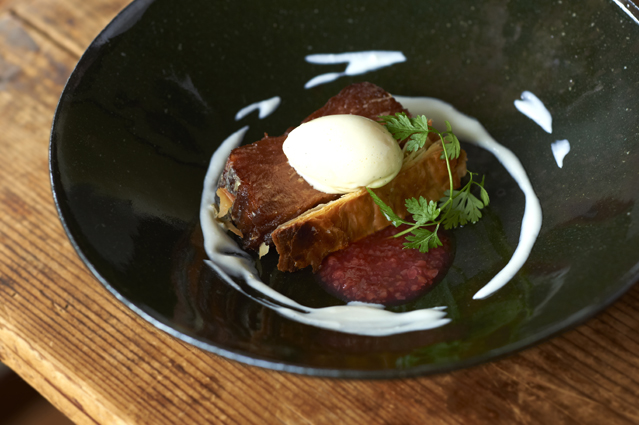
Tarte Tatin. A long bake in the oven intensified the sweetness of the Jonathan apples. While it looks plain enough, this traditional French dessert takes considerable effort to make.
“Basque dishes with a deeper flavor such as stewed beans, for example, might be better complemented by tableware with a matte texture that retains more of its earthiness,” Yasuyuki notes. He prepared us a triad of foods that went perfectly with the deep color, lustrous texture, and gently curving contours of Ito Kan’s bowl. The result was a lesson in how a single piece of tableware can assume different characters depending on what you serve in it.
“When selecting tableware, I’m attracted by pieces that give a sense of the artist’s handiwork and humanity,” Yasuyuki says. “To me, features like the angle of the bowl’s rim testified to Ito-san’s dedication and commitment. Because of the bowl’s luster and complex coloration, it strikes you very differently depending on the angle and direction you view it from. That’s part of its charm. It’s a dish that goes well with both Japanese and Western food. It fits in with a wide mix of styles and genres.”
I aspire to make wares that are relaxed and sensual.
— Ito Kan
“At first, you find yourself reaching for Ito Kan’s wares because you’re struck by their beautiful shape,” says Natsutsubaki’s Eto Aya. “Then they become part of your everyday tableware because they’re not overheavy and they’re easy to use. They’re sleekly designed, yet at the same time they possess the soft contours of clay. I love that the wonderfully balanced combination of the two. They’re the kind of dishes you’ll want to use forever. You never tire of them.”
We asked Ito Kan himself about this.
“Some things I make on the whim of the moment, but in many cases I’ll actually use an item at home and keep making minor changes to it. I’m constantly thinking of ways to make things easier to use. I’ll often spend time adjusting the depth of the bowl, the flare of the rim, and the thickness and weight to get them closer to perfection. Take this dish, for instance. It’s for serving curry, and for eight years I’ve kept making minor changes to it. In this version, I’ve tweaked the angle of the rim, thinking of how it might go better with a spoon. It’s flared just enough that it catches your fingers. I think that results in a somewhat sharper appearance than before.”

Curry plates by Ito Kan. He has tweaked the design repeatedly. “Tableware should be easy to use without being too obvious about it,” he says. “It would be kind of embarrassing if it were too stylish. A dish is just right when it only dawns on you gradually how easy it is to use.”
So does Kan aspire to make ceramics that get plenty of everyday use rather than for show? We asked him, and here’s how he replied.
“Basically yes, though I also think it’s important that ceramics look attractive when used for decorative purposes. Do they have what it takes to create mood or ambience? Size is irrelevant in that regard. It doesn’t matter whether you’re talking about a handleless tea mug or a tiny dish. Whatever I make, I try to make it beautiful as well as easy to use.”
This relentless insistence on beauty and ease of use is the reason why Kan’s creations are so loved by those who use them.
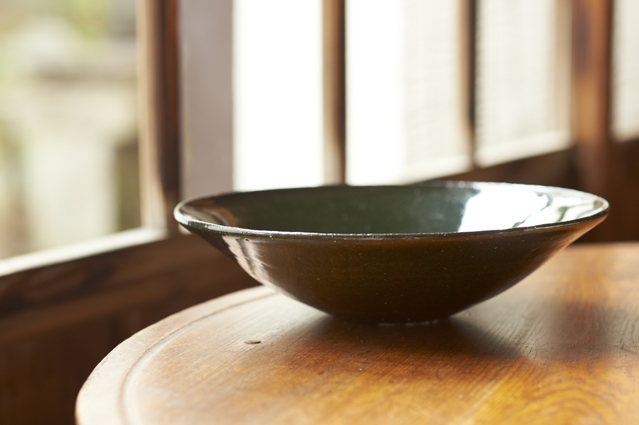
The “contact lens bowl” featured in this installment is part of a series that Kan launched at the request of a culinary expert who wanted a dish curved like a contact lens. It has a minimal foot to lend stability.
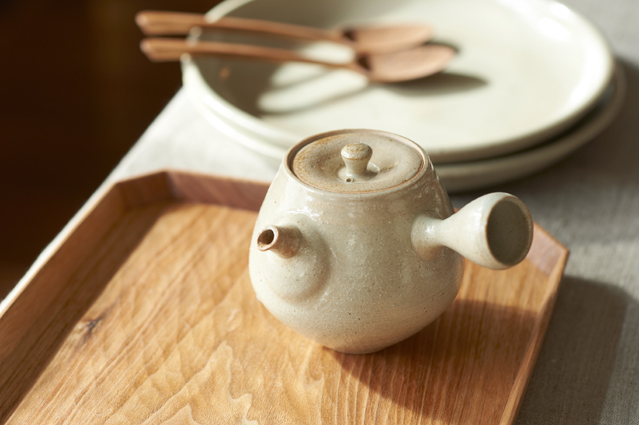
Kan made a Japanese rather than a Western-style teapot for this occasion with its Japanese theme. It takes skill and experience to make a teapot that is both beautifully shaped and easy to use, he notes.
“When I was at university, all I made was decorative objects. It was the golden age of decorative objects. I portrayed people’s faces as in totem poles. After graduating from university, all I made was legs below the knees, from the calves to the toes. The natural contours of the human body are a thing of beauty. The tone of the muscles, the bones they encase, the softness of fat. They’re beautiful whether a person is fat or thin. I became obsessed with making legs, whether the legs of the sumo wrestler Akebono or the legs of babies. The human body is my point of reference for depicting beauty and form even today. The experience I gained then serves me well now that I make pottery.
“Another key element is sensuality. One of the things that led me to abandon making decorative objects for the potter’s wheel was a week I spent assisting Nakazato Takashi of Karatsu. His work electrified me. It was the first time in my life that I found pottery sensual. The potter’s wheel is free and wild. It has no secrets to hide. It’s a pleasure to watch. Ever since, I’ve come to believe that being set in your ways kills the sensuality of a piece. Even now, a painting or a building or a culinary creation that looks sensual stirs something deep inside me.”
He concluded with an observation about his own output.
“My works used to be so delicate that people said they were afraid they would break. But since I became a father, they’ve taken on a greater thickness in a loose sort of way. Now my goal is to make pottery that seems wrapped in a mantle of air. Some things command attention, and they’re such a delight. At the same time, instead of churning out pieces that are all the same like they’re machine-made, I aspire to make wares that vary subtly, that are relaxed and sensual.”

After apprenticing at dining establishments in Japan and abroad, including a renowned Tokyo eatery and a natural foods restaurant, Muto Yasuyuki became chef at a French restaurant in the trendy Hiroo neighborhood of Tokyo. In 2009, he relocated to France, where he worked in Paris, Burgundy, and the Basque region. He returned to Japan in 2011. After working as sous-chef at a venerable French restaurant in another Tokyo neighborhood, Daikanyama, he became a certified JSA sommelier, further expanding his professional horizons.
